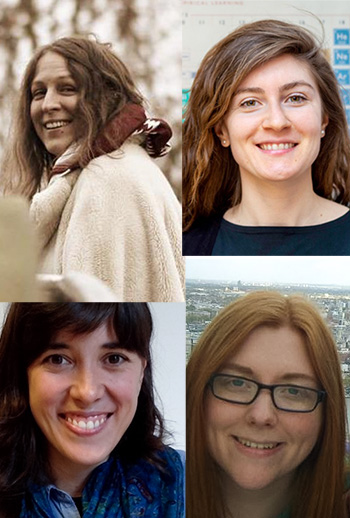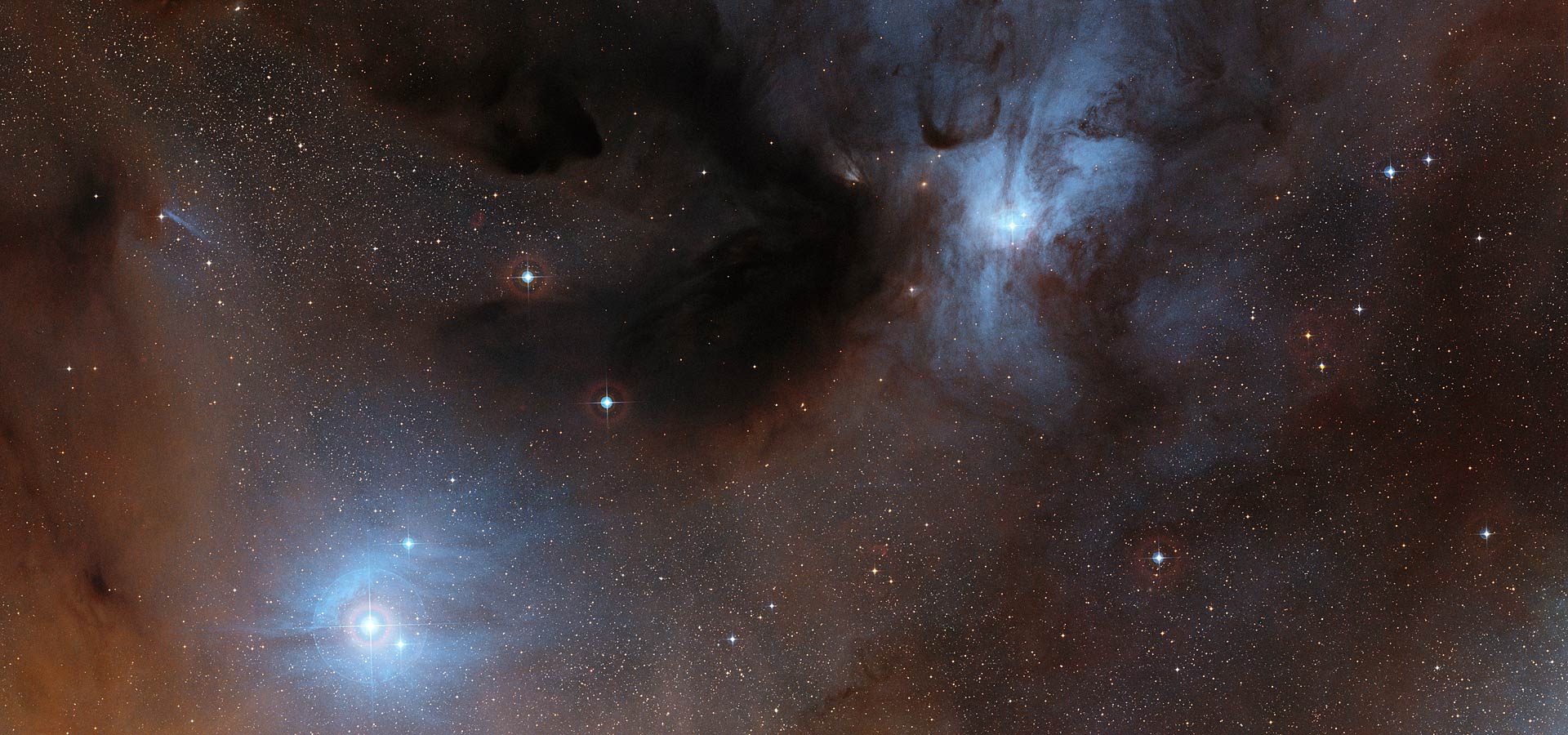- How data from ALMA was used to form a musical composition
- What the ALMA PILS survey is investigating
- How arts and sciences can benefit from collaborating together
Vera used data from the Atacama Large Millimeter/Submillimeter Array (ALMA), in which ESO is a partner, as inspiration for a stunning musical composition, which you can listen to in the YouTube video below or on the ALMA Protostellar Interferometric Line Survey website. We find out more about the composition and the data behind it from Vera and some of the scientists involved: her supervisor Giulia Perotti from the University of Copenhagen, Denmark, Catarina Fernandes from the University of Liége, Belgium and Hannah Calcutt from Chalmers University of Technology, Sweden and Nicolaus Copernicus University, Poland.
Q. Vera, why did you want to make a composition using astronomy data?
Vera Matenaar (VM): Music is a huge part of my life. I started playing the piano when I was six years old and from there I had twelve years of classical music education. Now, I play in three bands, teach piano at the Mukl music school in Kleve, Germany, and am also involved in event technology.
However, astronomy is a subject that has always fascinated me. It was my childhood dream to visit a large telescope! I started studying for a degree in mathematics and physics, but didn’t complete this as I was raising my three children.
The idea for this composition came together when I was sitting in the garden one evening, and I remember thinking: wouldn’t it be really great to make an orchestra of the stars in the sky?
Q. Were you aware of any similar projects that have been done in the past?
VM: Having heard previous examples of where scientists had brought sounds into the audible range, for example with bat ultrasound and previous interpretations of astronomy data, I wanted to make something more musical for my bachelor’s thesis. The examples I had heard were more abstract, and not exactly pleasant — to my ears, anyway. I wanted to use harmonious sounds, with orchestral instruments, because we have a completely different response to these than to a ‘beep’ or other noise.
Q. How did you get involved, Catarina?
Catarina Fernandes (CF): I was the “connecting point” with Vera, since we have known each other for a few years. I’m an astrophysicist, and at the time I was a PhD student at the University of Liége, characterising and studying the evolution of very low-mass stars connected to the SPECULOOS (the Search for habitable Planets EClipsing ULtra-cOOl Stars) project. (Editor's note: the SPECULOOS Southern Observatory is hosted by ESO at its Paranal Observatory in Chile, about 500 km from ALMA.)
When Vera came to me with this idea of combining music and astronomy, I was really excited! We discussed what was already out there using astronomical data as inspiration for music. People were creating music with transits of exoplanets for example, and we wanted to ensure that this project would be a new idea. I was taking part in a collaboration with the University of Copenhagen, sharing an office with Giulia Perotti and I thought that her work could be interesting for what Vera needed, so I talked with her.
Q. What do you work on, Giulia? How could this be translated to music?
Giulia Perotti (GP): I’m currently a PhD student in astrochemistry at the University of Copenhagen, looking at the rotations and vibrations of molecules in very young star-forming regions. When Catarina contacted me, I thought we could try to convert an astronomical spectra of rotating molecules into music!
VM: The motions of these molecules can be expressed using their measured frequencies, which is convenient because musical tones can also be expressed as frequencies. For example, orchestras tend to tune to a ‘concert A’, which can be expressed as a frequency of 440 Hz. We could therefore draw a parallel, and translate these rotating molecule frequencies into audible tones.
GP: After speaking with Catarina, I was very enthusiastic about Vera’s project and agreed to be her supervisor straight away. My role was to guide Vera in the astronomical data analysis, identifying the signals of the rotating molecules from the noise and correctly translating them into audible notes. I gave her a small spectrum of a system that I was studying, and unfortunately it turned out that this spectrum wasn’t molecule-rich enough for the number of frequencies she was hoping for. We needed something more complex. That’s when I decided to contact Jes Jørgensen and Hannah Calcutt, who work with the ALMA Protostellar Interferometric Line Survey (PILS), and get them involved.
Q. Hannah, how did you feel about being invited to be part of this project? Can you tell us a little more about the ALMA PILS data?
Hannah Calcutt (HC): I’m a musician myself as well as an astronomer, so I have thought in the past that this combination of interests could lead to something. Unfortunately, I’ve never had the time to explore this idea at all. So when Giulia contacted me, I thought this would be a very cool project to be involved in.
The specific data set that Vera used for the composition is from IRAS 16293-2422B — a low-mass star in the early stages of formation within Rho Ophiuchi, one of the closest star forming regions to our Solar System. IRAS 16293-2422B is part of the IRAS 16293-2422 system, which contains several forming protostars. The central protostar in IRAS 16293-2422B has heated up some of the material around it, so we are able to see the chemistry in a lot of molecules that are emitting energy in this region.
Q. Why are you interested in the chemistry of these regions and why did you use ALMA?
HC: Studying this chemistry is very important not only to understand the processes that allow stars to form but also because it can give us insights that link to biology on Earth. You can compare, and really understand, the whole chemical pathway going from star forming regions to chemistry in the Solar System and in life itself. Therefore this region we’re looking at has huge importance for a range of different interdisciplinary areas around astrobiology and astrochemistry.
ALMA has been absolutely crucial to understanding all of this. We need the combination of high resolution and high sensitivity that ALMA provides to be able to resolve all of the many components that we have.
Q. What has the PILS survey found?
HC: We’re coming towards the end of the PILS survey, led by Jes Jørgensen, professor at the University of Copenhagen. We’ve been able to show that if you systematically survey the chemistry in a star forming region covering a broad range of frequencies, then you’re able to see patterns in the chemistry that you might not identify if you do a targeted survey for certain molecules. This has massive implications for linking the chemistry of low mass sources to chemistry studies in comets and showing that there is some chemical variability between low-mass, intermediate and high-mass stars, but the differences between these objects are less dramatic than we expected. So I think it’s a very important survey as a benchmark for the ultimate goals that we want to achieve.
Q. How did you convert the astronomical data into music?
VM: I mentioned that both the astronomical data and music are represented by frequencies. We can hear that different musical instruments sound unique as playing a musical note (the fundamental frequency) on one type of instrument also produces unique combinations of higher notes or frequencies, known as harmonics. So, we recorded ten different orchestral instruments and extracted their tones and harmonics. We looked for similar relationships or ‘harmonics’ in the astronomical data, with the slower rotating molecules representing the fundamental frequencies and the faster rotating ones the associated harmonics, an idea from Friedrich Wyrowski at the Max Planck Institute for Radio Astronomy. To do this, we extracted the individual measured frequencies and intensities of thousands of molecular lines in the ALMA data. These were mapped to the sounds of different instruments using mathematical approximations to identify which frequencies in the data were multiples of the instrument tones and harmonics, allowing us to assign certain musical notes on certain instruments. The relative intensities of the instrument tones comes from the strength of the molecular lines. This mapping was determined with the help of Brittney Scifres and aerospace engineer André Schmidt, from the University of Stuttgart.
Q. Vera, can you talk us through the composition? Were there any ideas relating to astronomy that you wanted to convey?
VM: The introduction to the composition starts with the original sound of the entire spectrum of molecules, creating a ‘swoosh’ before playing the instrument tones we approximated, as they would sound in the order the spectrum was recorded. After this, my artistic interpretation begins, limited to the tones that we approximated from the spectrum. The inspiration behind the composition is the birth of the stars, which is why the composition slowly builds up to the climax and ends as it began with the sound of the entire spectrum. This represents the life cycle of stars — new stars form from the matter expelled from dead or dying ones.
Q. A question for the astronomers: do you think there is a role for arts and science collaborations like this one?
GP: I think there surely is a role for projects which bridge across arts and science. Particularly in subjects like astronomy, where the science can be quite complex to perceive, it can really help aid in understanding and fully appreciating a topic. We should really try to foster these types of synergies between science and arts.
CF: Artists have always been inspired by the stars, and it’s beautiful that a musical piece that involves the data itself can be created. Although astronomy is such an inspiring subject area, it can be very difficult to make sense of complicated data. I think it’s really beautiful that an artist or musician can bring emotion out of such data. It’s inspiring for other musicians, and for astronomers themselves.
HC: We’re in an age right now where a lot of people are distrusting science, and I think this kind of project is important because it allows people to connect with science in a different way.
When I was at school, I was taught that art and science are two very different pathways. However, I find that having a creative side is very important for scientists to be able to communicate new ideas clearly. Sometimes displaying a beautiful image or using some other kind of medium to clearly represent your science can be a really important thing to get people excited and to encourage discussions about what you’re doing.
Q. Lastly, Vera, what do you think of the end result?
VM: I am surprised but really happy that, with the limited number of tones, such a composition could be made. I feel like this composition was created as a collaboration between me, a musician and composer, and the Ophiuchus star-forming region data. That is something very special for me.
Did you know?
Another composition which includes the sounds of space was released by Chilean pop artist Flangr in December. The song Sorry, also featuring the Californian band Fashion Jackson, uses the sounds captured and encoded by ALMA, in collaboration with another project, ALMA Sounds.
Links
- You can listen to Vera’s musical composition on YouTube or on the ALMA PILS website.




